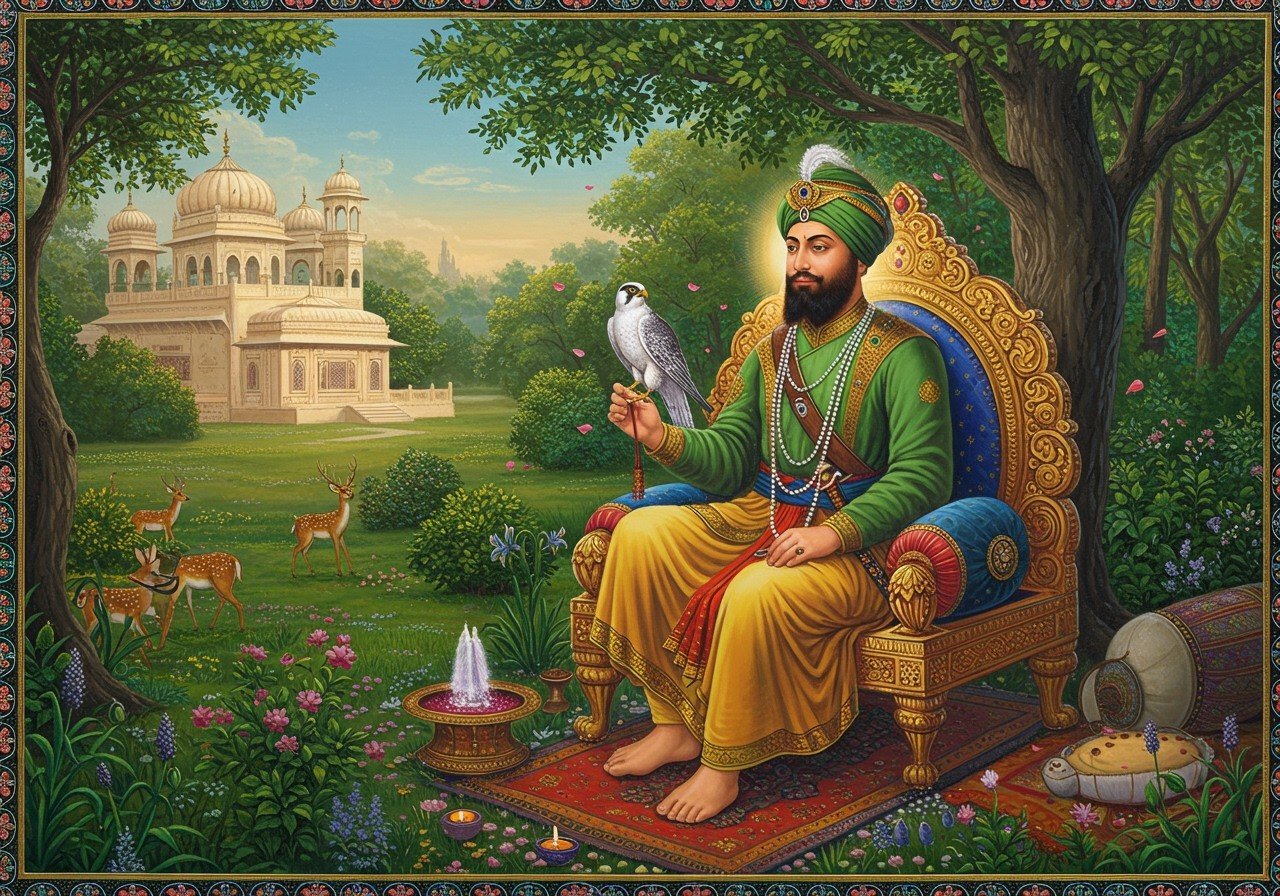
Guru Har Rai Ji, the seventh Sikh Guru, graced this world from 1644 to 1661. His life was a testament to compassion, peace, and selfless service, qualities that deeply resonate with Indian culture and spirituality. He was known for his deep empathy and his commitment to the wellbeing of all beings. His leadership, during a time of political upheaval, showcased the strength found in peaceful resolution and spiritual fortitude.
Early Life and Family
- Born on January 16, 1630, in the sacred town of Kiratpur Sahib, Punjab, Guru Har Rai Ji’s birthplace itself holds deep spiritual significance for Sikhs.
- As the grandson of Guru Hargobind, the sixth Guru, and son of Baba Gurditta and Mata Nihal Kaur, he was raised in an environment steeped in devotion, courage, and service. His upbringing instilled in him a strong sense of duty and a profound love for the Divine.
- He married Mata Kishan Kaur (also known as Sulakhni Ji) in 1640 and was blessed with two sons, Ram Rai and Har Krishan, the latter destined to become the eighth Guru. His family life reflected the values of love, respect, and spiritual guidance.
The Path of Guruship
At the tender age of 14, on March 3, 1644, Guru Har Rai Ji assumed the mantle of Guruship. This marked the beginning of 17 years of devoted service to the Sikh community and to humanity at large. He embraced the responsibility with grace, wisdom beyond his years, and a deep commitment to upholding the teachings of his predecessors. His leadership provided strength and solace during a period of considerable social and political change.
A Legacy of Compassion and Service
- Military Prowess and the Spirit of Peace: Though he maintained a formidable force of 2200 mounted soldiers, a testament to the Sikh tradition of self-defense, Guru Har Rai Ji was a staunch advocate of peace. He believed in the power of dialogue and understanding to resolve conflicts, demonstrating that true strength lies in compassion and non-violence. He emphasized that maintaining peace was not a sign of weakness but a testament to inner strength and wisdom.
- Humanitarian Endeavors: Guru Har Rai Ji’s compassion extended beyond spiritual guidance. He established hospitals and dispensaries, ensuring that the sick and needy received medical care, regardless of their background or faith. He promoted natural remedies and herbal medicine, recognizing the healing power of nature. His own medicinal garden provided solace and relief to many, highlighting his commitment to the well-being of all.
- Champion of Sikh Values: Guru Har Rai Ji dedicated himself to strengthening the core principles of Sikhism. He tirelessly promoted meditation, devotion, and service to humanity as pathways to spiritual growth. He emphasized the importance of self-discipline and cultivating love for the Divine. He also stood as a staunch advocate for the rights and dignity of all individuals, spreading the message of equality and respect.
- Sharing the Light of Sikhism: His commitment to sharing the wisdom of Sikhism led him to establish new Sikh centers and send his disciples to various regions, including eastern India and Rajasthan. Through these endeavors, he ensured the continued growth and flourishing of the Sikh community, sharing the light of Sikhi with people from all walks of life.
- Navigating Mughal Relations: During a time of delicate political balance, Guru Har Rai Ji skillfully maintained peaceful relations with the Mughal rulers, demonstrating both wisdom and diplomacy. His act of providing medical care to Dara Shikoh, son of Emperor Shah Jahan, exemplified his compassionate nature and commitment to healing. Even when summoned by Aurangzeb after supporting Dara Shikoh, he stood by his principles with courage and grace.
- Choosing a Successor: Guru Har Rai Ji’s decision to appoint his younger son, Har Krishan, as his successor was driven by his unwavering adherence to the purity of Sikh teachings. He believed that his elder son, Ram Rai, had compromised the integrity of the sacred Bani, and thus chose Har Krishan to carry forward the true spirit of Sikhism.
Honoring Guru Har Rai Ji’s Legacy with Poojn.in
As we reflect on the life and teachings of Guru Har Rai Ji, we are reminded of the importance of compassion, service, and spiritual devotion. At Poojn.in, we offer a wide selection of authentic puja items to support your spiritual practice and help you create a sacred space in your home.
For those seeking to deepen their connection with the Divine, we offer a curated selection of items perfect for commemorating Guru Har Rai Ji’s legacy. These include:
- Pure Chandan Tilak: For blessings and spiritual practices.
- Stainless Steel Achmani: For sacred rituals and purification.
- Brass Darpan (Mirror): For self-reflection and inner clarity.
- Holy Food Items: For offerings and prasad.
Explore our complete collection at Poojn.in and find everything you need for your spiritual journey.
Continuing the Conversation: Understanding Guru Har Rai Ji
Many seek to deepen their understanding of Guru Har Rai Ji’s life and teachings. Here are some common questions and answers:
What makes Guru Har Rai Ji so revered? Guru Har Rai Ji is honored for his unwavering compassion, humility, and dedication to peace. He embodied these virtues throughout his life, serving as an inspiration to Sikhs and others seeking spiritual guidance. He held the Guruship from 1644 to 1661, a period marked by significant challenges.
What were the core principles of Guru Har Rai Ji’s teachings? He emphasized the interconnectedness of all beings and the importance of living a life of service, compassion, and humility. He encouraged his followers to cultivate a deep connection with God through devotion and prayer while actively working towards the betterment of society.
What was Guru Har Rai Ji’s significance in Sikh history? During a time of political turmoil, Guru Har Rai Ji played a crucial role in preserving Sikh teachings and traditions. He promoted peace and understanding, fostering the growth of the Sikh community while maintaining positive relations with the Mughal Empire. He skillfully navigated complex political situations, demonstrating wisdom and diplomacy.
How did Guru Har Rai Ji contribute to the development of Sikhism? He expanded the reach of Sikhism by establishing new centers of learning and worship, ensuring the preservation of sacred texts, and sending his disciples to spread the teachings throughout India. His focus on compassion and service helped solidify these values as central to Sikh identity. He also upheld the military tradition of his grandfather while always prioritizing peaceful solutions.
How did Guru Har Rai Ji address conflict? A staunch believer in non-violence, Guru Har Rai Ji prioritized dialogue and peaceful resolutions. He led by example, demonstrating that true strength resides in the courage to choose peace over conflict. His commitment to peaceful coexistence served as a powerful message during a tumultuous era.
What are some of Guru Har Rai Ji’s notable achievements? His pioneering efforts in healing and medicine are especially noteworthy. He cultivated a vast herbal garden and offered medical care to all who sought it, regardless of faith or social standing. His compassion extended to all beings, reflecting the Sikh belief in the oneness of humanity. He also played a significant role in strengthening the Sikh community and preserving its teachings.
How is Guru Har Rai Ji remembered today? Guru Har Rai Ji’s legacy lives on through his teachings of peace, humility, and selfless service. He is remembered as a beacon of hope and a symbol of spiritual strength, inspiring generations to follow the path of compassion and devotion. His life serves as a reminder of the power of peace and the profound impact of selfless service.
For those who would like to delve further into Sikh history and spirituality, you may find these resources helpful:
- Lord Shiva Temples in Maharashtra: Significance and History
- Kopineshwar Mandir: History, Significance, and Rituals Explained
- Parshuram’s Divine Legacy: Temples, Legends, and Rituals
- Parshuram’s India: A Pilgrimage Guide to His Sacred Sites


